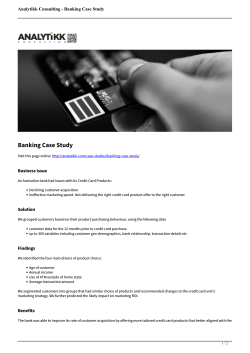
Jvion - nchica
Predicting What Matters Using Predictive Analytics to Reduce Suffering, Save Lives, and Optimize the Cost of Care Predictive Analytics for Population Health Management NCHICA Learning Objectives By the end of today’s session, you will be able to: • Define predictive analytics, summarize the types of predictive solutions in the market, and list the key differences between them • Develop a business case for the adoption of predictive analytics within your own facilities • List the critical components to driving meaningful and effective results from predictive analytics • Assess organizational readiness to adopting a predictive analytic solution and develop a highlevel engagement plan 1 Why Healthcare Demands Predictive Analytics Predictive Analytics Quality Cost Savings 2 The State of Predictive Analytic Adoption 3 The State of Predictive Analytic Adoption 4 The Hard Dollar Truth Hip Replacement Pressure Ulcer 13 day stay $3K/LOS $39,000 New Patient – Elective Surgery No Pressure Ulcer – Patient Hip Replacement Goes Home (3 day stay; $7K/LOS) 10 day stay $5K/LOS $50,000 Total for 13 Days $50,000 $21,000 $71,000 5 Steps to Building a Predictive Analytics Business Case • What are our biggest clinical risks? • What are our biggest financial risks? • How can our solution enable the overall organizational strategy? • What impact will the solution have on IT? • What business resources are required to enable the solution? • Is this solution proven in the field? Determine Risk Areas Prioritize for Predictive Analytics • What are the high cost, high value areas that we can impact? • Where are non-invasive interventions most helpful? • Where will we have the highest levels of adoption? • What barriers exist to intervention effectiveness? • What are the requirements for the solution to work in our current environment? Define ROI • What is our clinical ROI? • What is our financial ROI? • What does our ROI look like near and long term? • How do we account for barriers to intervention effectiveness? • How can we leverage our solution to gain market eminence? 6 Determining Risk Areas Current areas of clinical/financial risk Potential areas of solution risk Understand current financial and clinical pain points Determine organizational maturity around valuebased models Assess solution impact to IT resources and infrastructure Account for functional/clini cal resource requirements Determine solution viability Including attributable cost and penalties associated with: • Hospital acquired conditions • Hospital acquired infections • Readmissions Including scores against: • Clinical Process of Care Domain • Patient Experience of Care Domain • Outcome Domain • Efficiency Domain • • • • • • Infrastructure requirements Data requirements Integration options Proven experience with select EHR(s) • • Model build requirements Testing requirements Training requirements • Accuracy on other data and on your organization’s data Case studies from similar organizations 7 Prioritizing for Predictive Analytics High revenue impact Intervention Effectiveness 20% High mortality impact 40% High intervention impact 60% Influenced by: • Intervention cost of each disease • Current capacity and cost of additional capacity to perform prevention (case managers, etc.) • Revenue loss when prevention occurs (if you have no issues filling beds, this should be balanced with incremental revenue when prevention causes beds to turn quicker) • Slowness to adapt change Pure Potential (100%) Pure potential represents the accuracy of the solution 8 Defining the ROI Projected 5 Year Total Savings Medicare AMI $1.610M $3.221M COPD $2.006M $4.011M HF $3.614M $7.228M Hip/Knee $0.547M $1.094M PN $2.275M $4.550M $10.052M $20.104M Cumulative Total Projected 5 Year Medicare Savings Year 1 2 3 4 5 AMI $145,200 $250,800 $343,200 $409,200 $462,000 COPD $174,400 $316,100 $425,100 $512,300 $577,700 HF $312,000 $559,000 $767,000 $923,000 $1,053,00 0 $43,200 $86,400 $115,200 $144,000 $158,400 PN $195,000 $351,000 $481,000 $585,000 $663,000 Yearly total $869,800 $1,563,30 0 $2,131,50 0 $2,573,50 0 $2,914,10 0 Hip/Knee Non-Medicare Projected total 5 year savings on readmission prevention using predictive analytics: $30.16M 9 Types of Predictive Analytic Solutions Examples Definition Clinical Rules Based Solutions Statistical Algorithms Deep Machine Learning These solutions compile clinical rules derived from evidence-based clinical studies to identify risk at a defined cohort level These solutions use statistical algorithms built from evidence-based studies to flag potential risks within a patient population These solutions use deep machine learning capabilities to identify patient risk. These models are continually refined and more accurate as new data is fed into the system Typically integrated into the EHR LACE scores for 30-day readmissions, Braden scores for pressure ulcers Predictive analytics companies Patient Phenotype Approach Clinical Rules Based Solutions Statistical Algorithms Deep Machine Learning Patient Clusters Combined capability to understand what isn’t inherently visible with clinical intelligence to more accurately identify, map, and predict patient-level risk What This Means for Population Health Proactively Understand Population Risk Programs that most effectively diminish burden Patients most likely to engage Prioritization based on risk Identification of interveneable risk ROI and yield tracking 12 Build vs. Buy Build Data Scientist Infrastructure Data Statisticians Testing Resources Buy Resources • • • • • Time 1-2 years 6-10 weeks Capabilities 1-2 use cases Dozens of pre-seeded use cases Risks • Investment may not yield predictive capabilities at target accuracy levels • Resource constraints may extend timelines • Adoption and change management challenges Adoption and change management challenges still exist but can be mitigated through solution demos and ROI measures • Limited IT involvement • Data Scientists can be leveraged for other projects 13 What Actually Works in A Hospital Practicality Accuracy Scalability Flexibility Affordability 14 Getting Our People Engaged Clinician adoption is critical to our success. Our solution had to: • Easily fit into the clinician’s workflow • Demonstrate immediate accuracy and effectiveness • Be proven and hold up to scrutiny • Be easy to use and understand • Be accepted by fellow clinicians Is My Organization Ready? Strategy • • • Alignment to value-based and at-risk models Established goals focused on quality and population health outcomes Appointment of a CMIO/CHIO • • Technology Leadership Understanding of • predictive analytic applications IT support for • adoption Presence of a physician champion C-suite alignment across all functions Established goals that can be enabled through predictive analytics • Clinicians • • • Established network of peer groups that enable adoption of new solutions Understanding of clinical predictive analytic application Understanding of how clinical predictive analytics fit into the workflow What Are My Next Steps? Establish organizational goals that are aligned to new value and quality standards Ensure IT education on predictive analytic solutions and potential impact (EDW, SAAS, etc.) Select physician champion and determine expected ROI from solution across target diseases and conditions Communicate expected ROI to clinicians and develop a strategy for integration of predictive analytics into workflow Learning Objectives You should be able to: Define predictive analytics, summarize the types of predictive solutions in the market, and list the key differences between them Develop a business case for the adoption of predictive analytics within your own facilities List the critical components to driving meaningful and effective results from predictive analytics Assess organizational readiness to adopting a predictive analytic solution and develop a highlevel engagement plan 18 Using Predictive Analytics to Reduce Suffering, Save Lives, and Optimize the Cost of Care Q&A 19
© Copyright 2025









